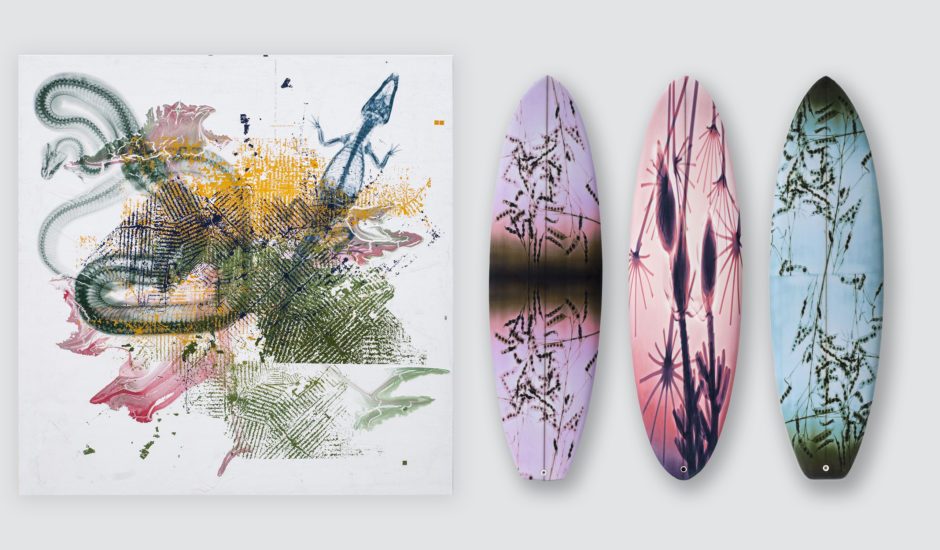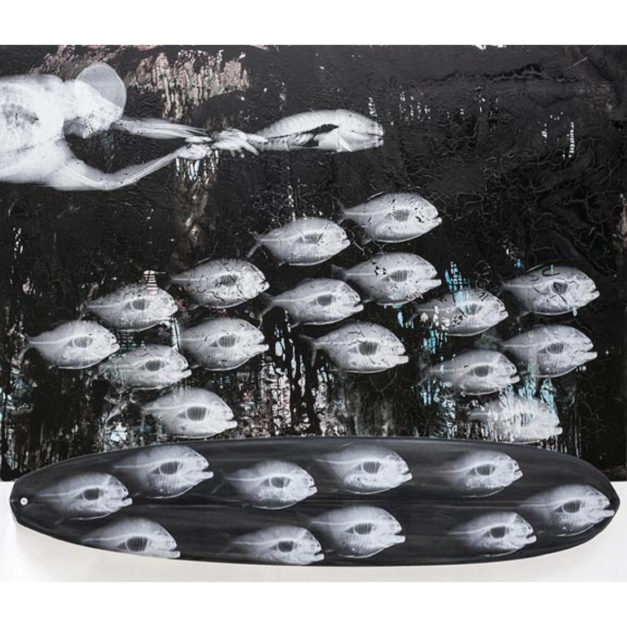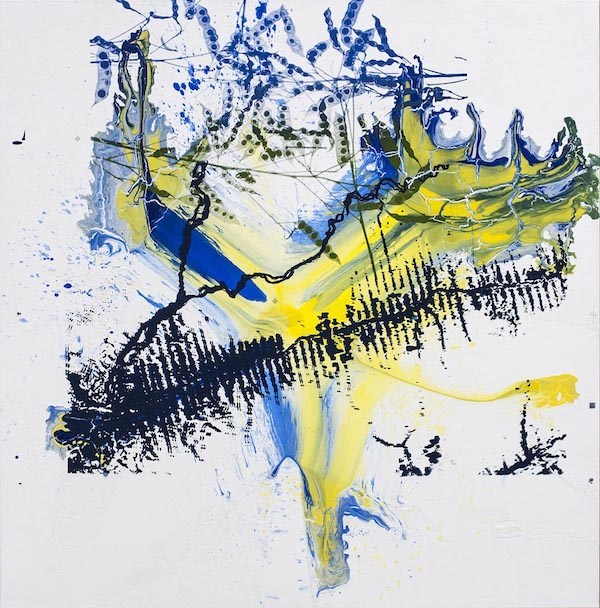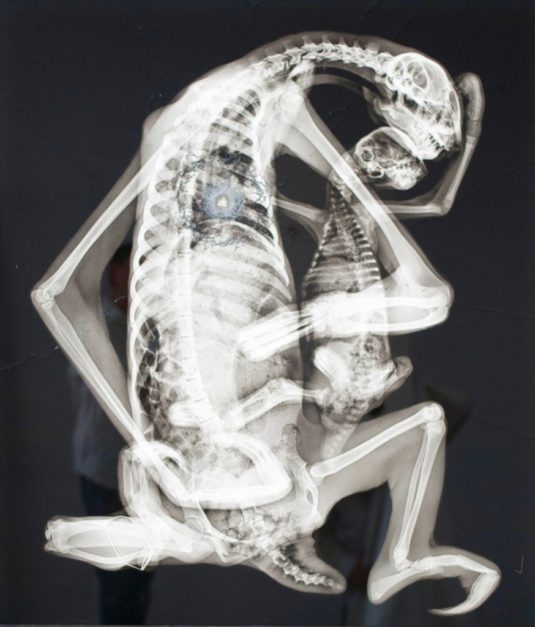
January 16th, 2019 by Kara Westernman


Artist and entrepreneur Steve Miller thinks big. He is passionate about the world, the connectivity and integration between art and commerce, science and art, science and nature, nature and art, and ultimately our connection to the health of the planet and the other species that live on it.
In the preface to Mr. Miller’s book, “Radiographic: X-Ray Photo Inventions,” the naturalist Carl Safina writes: “It’s not just about human-to-human interaction, it’s about all interaction. We’re bound to the rest of life in a network, including not just all living things but the energy and non-living matter that flows through the living, making and keeping us alive as we make it alive. And unless we embrace the reality we’re in — and reality’s implications — we’ll face big problems. To keep life alive, what’s important is: preserve the process.”
In his barn-like industrial building by the railroad tracks in Sagaponack, Mr. Miller’s studio is filled with his large-scale artworks, collages of satellite land-clearing images and X-rays of Amazon flora and fauna in silk screen overlays, mostly on canvas, but also on surfboards, skateboards, pillows, scarves and leggings.
Fifteenth century Chinese pots cluster on the coffee table in his mid-century sitting room, and moving above his 1960s orange semi-octagonal couch is a school of piranhas from the Amazon river, their white X-rayed bones arrayed across a massive black canvas background, with the artist in X-ray himself at the top, bone-arms outstretched, holding onto the skeleton of a giant river fish, and a silkscreened surfboard at the bottom, a piece aptly named “School Of The Abyss.”
“Everything is integrated. Everything is connected. All energy is in motion,” he told me. “The long-term cost of not paying attention to this…is enormous.
Most of the pieces currently on display in his studio are the products of a series he began in 2005 after visiting Brazil and the Amazon for the first time. He called the series, which grew to be a ten year project, “The Health of the Planet,” the fruit of which is his gorgeous new book, with a wonderfully non art-speak introduction by naturalist Carl Safina. The book is of course about connections, both the visible and the ones not so apparent until you go beneath the surface.
“The place was so incredibly beautiful and extraordinary that I felt ‘I need to be here more!’ It’s beautiful and fragile. And like most beauty, and most important things in life, they are very fragile,” he says.

On his first trip to a Brazilian island called Ilha Grande, at the edge of the Atlantic rainforest, Mr. Miller became fascinated with huge jackfruits, jaca, the size of watermelons, which he saw hanging from trees. When he saw a mutant double jackfruit on one stem that looked like a pair of huge lungs, the idea for the project clicked.
“If the Amazon are the lungs of the planet,” he told me, “I’d give the planet a medical checkup, a metaphorical checkup, by X-raying the lungs. I felt like I had the tools and technology to do an environmental analysis of the health of the planet.”
“The Amazon jungle is where the CO2 exchange takes place, and it takes place on a massive scale,” he added. “What’s happening now, sadly, is that the heat level, the CO2 levels are now greater than what the plants can process. The forests are actually collapsing, just at the moment that we need this the most. We are in a very scary place right now.”
I asked Mr. Miller what it was like convincing a clinic in Brazil to let him put a giant mutant jackfruit into their MRI machine.
He sighed and told me it was a long story. It took three years to get a clinic in Brazil to work consistently with him on his project, scanning the plants and animals native to the Amazon. He chose a town with a zoo and a fishing port, an aviary and an aquarium.
He developed a relationship with the zoo in which they would trade. Since the zoo had little or no money or equipment, Mr. Miller would bring animals that needed to be X-rayed into the clinic for treatment, as well as other animals — like sloths, alligators, piranhas, pythons — that Mr. Miller wanted to explore.
“We have some X-rays of live, although somewhat sedated, alligators. I hung out with sloths, and got to hold some. We X-rayed the python live, but fed it a rat first to slow it down considerably.”
Miller began experimenting with new technologies, like electron microscope imaging, sonograms, electrocardiograms, CAT scans, X-rays and MRIs in the 1980s in order to explore a new kind of portraiture, partly because he got tired of the old argument between artists about whether or not painting was dead.
“You always think of a portrait as a form of identifying the sitter, but now with technology and forensics you identify somebody with the technique of their data, their scans, their medical records and dental records. It inverted that idea of the painted portrait. It was also interesting to think of the Renaissance idea that if you look into the eyes you can look into the soul, and now you can actually look inside the body.”
By the 1990s, he was using X-ray imaging to see inside of iconic fashion pieces. Mr. Miller’s mother had an exquisite collection of couture wardrobe items — Vuitton luggage, Chanel bags, Roger Vivier shoes, among other treasures — and he decided to X-ray these objects as a way of processing her passing.
“You know how when a Pharaoh dies, or a king or a queen, maybe a Chinese warlord — they bury you with all your stuff, so I thought I could do a show for my mom, X-raying all of her stuff.”

He shows me the intricacies of some of the huge paintings in his studio. On one nearly seven-foot tall canvas from 2015, titled “Forces At Play,” he has used what he calls “pigment dispersion” which produces a flowing tactile effect, like a topographical map, over which there are X-rays of a live alligator and a Python. Silkscreened on top of these are satellite images of land clearing in the jungle, stark geometrical patterns of disruption amidst the curving and fluid shapes of the animals and pigment.
On another canvas is what is called a “fishbone pattern” of land clearing, where a more fluid river-like cord is the spine of the fish, off of which the lines of the swaths of land clearing emerge as the rib bones coming off of both sides.
“These are aerial satellite maps. So let’s say this one was from 1980 and this one from the ‘90s. It looks like from 25 percent clearing to 75 percent clearing in ten years,” he says. “The tipping point is going to happen when the oceans have totally changed the commerce of anything near the coast . What’s going to happen when that economic cycle gets interrupted? We’re coming to the point of what some people think is called collapse.”
Also integrated in many of the pieces from this cycle are graphic images of literal electrical connectivity. After exploring the flora and fauna in Brazil, Miller ventured into the hive of concentrated human activity to be found inside a Brazilian favela — lawless zones made up of mostly wood huts, and generally run by drug lords — to find images of human activity.
“This image is from one of the largest favelas in Rio, called Brasilia. It’s kind of crazy. You have to get permission to go in,” he says, then shows me an image of a fantastical jumble of knotted electric wires swaying above a roofline, vying for space and connectivity.
These bootlegged strands of electricity, called “cat whiskers” look like strands of plant life when silkscreened onto his canvases, but are actually representations of the human activity causing the land clearing in the jungle, the unending and ever-growing need for resources.
“This is one photo of the electrical system of the favela. So the need for the resources, the chaotic need, the reason for the land clearing, is in this graphic representation. It’s the human activity of necessity,” he says.
Mr. Miller is unabashedly commercializing his work, in a big way. He has done three sets of windows for Bloomingdales over the course of three years, two of his X-ray printed surfboards and one of his Ying/Yang Python skateboards.
“It’s really exciting. I’ve done three different clothing lines. One is a surf line for a company in Brazil called Osklen, which is very eco-oriented,” he says. “They do all natural cotton, and have an amazing manufacturing process, have won dozens of award for doing it right.”
His motives for making his images accessible to a wide audience, beyond the obvious ones of creating enough revenue to support himself and his projects, are again all about connectivity. Mr. Miller understands that the change the planet needs is probably not going to come from the one percenters, but is much more likely to come from someone who grew up in a favela, a surfer, or a young skateboarder.
“It’s about being in the world. The thing is to get the conversation out into the world. If it’s just a bunch of art lovers or one percenters who can buy it, it’s not that interesting,” he says. “To be available to any format of discussion is way more interesting to me. If my images are limited to an art gallery, it’s a very small audience. I’m connecting the dialogue to the largest audience possible and getting rid of the “Art” part of it, and foregrounding the content as opposed to the context. I want to be out in the world as much as possible.”
Miller the entrepreneur has also created a software company called Arternal, a Customer Relationship Management (CRM) software for art galleries that collects data and tracks engagement, hopefully connecting collectors with art, and selling art, so that artists make money.
“I find working with data equally creative,” he says. “Electron microscopes told me something different, computers told me something different, and now there’s this news lens of data. I’ll incorporate this into my work somehow. The bundles of wires you saw from the favela — that’s data transmission, that’s where we are.”
We closed our interview excitedly following each other’s Instagram handles.
Radiographic can be found at The Parrish Museum in Water Mill, Barnes & Noble and Amazon.
You can find Steve Miller on Instagram: @stevemillerdotcom
His archive: stevemiller.com
His store: stevemiller.art
His data company: arternal.com
Kara Westerman is a fiction author, teacher, oral history facilitator and writing workshop leader. She received her fiction MFA from Sarah Lawrence College and produces and hosts the podcast Phantom Hampton: Stories From Where The Rest of Us Live.
Read the original article at East End Beacon‘s website.
